How to Treat Sore Hocks in Angora Rabbits
Learn how to treat sore hocks with herbs and natural remedies for happy, healthy, angora rabbits. Here are the tips I use to heal sore hocks fast.
Your rabbits’ hind legs carry their weight all day long. Most angora rabbits spend their lives in cages or hutches. Wire cage bottoms can cause pressure points on the bottoms of the rabbit’s feet, causing swelling, abrasion, and inflammation. Called ‘sore hocks, the condition exhibits as a bare patch on the bottom of the feet, with broken skin and scabbing. In extreme cases, such as when the rabbit is standing in manure or wet bedding, staph or strep infection can complicate the matter, leading to abscess and infection on the bottoms of the rear feet. In extreme cases, the front feet will also be scabbed or abscessed.
Rabbit feet were designed to sit on grass and soft earth, allowing their toes and claws to sink into the ground and providing cushion and support for the foot. Unfortunately, it’s difficult to replicate this surface indoors.
Sitting on a hard surface causes the toes and the front part of the foot to lift slightly, shifting the weight to the heel (hock) of the foot, and applying pressure. The heel is not intended to support a rabbit’s weight, so pressure sores can develop. Wire cage flooring and most types of carpet are abrasive to a rabbit’s feet.
Many rabbits develop a small, calloused area at the tip of their heel under the flap of fur. When this area becomes bare, red, or inflamed, there is cause for concern. Ontario rabbit education
Sore hocks are a symptom of a deeper problem. Sore hocks rarely occur in isolation. The rabbit books suggest that if a rabbitry has sore hocks, the fault is the rabbit — thin skin on the feet, lack of wool cover, or a genetic propensity toward inflammation in the foot zone. The common rabbit advice is to cull the rabbit and don’t use them for breeding. I suggest that the problem of sore hocks is a management problem, more than a genetic problem. Rabbits that are forced to remain with weight on their hind legs, on a wire cage bottom will inevitably develop sore hocks. Add to this a manure pile or urine soaked feet, and infection as well as inflammation is bound to occur.
Sore hocks are easier to prevent than they are to treat. After raising angora rabbits for 12 years, I have seen my share of sore hocks, and in no circumstance was it the fault of the bunny. In every case, it could be traced to a management issue, which, once corrected, allowed the bunny to heal and stopped the occurrence of the problem.
We had a run of sore hocks in our rabbitry last winter. On close examination, we realized that a change that we had made in the cage design was promoting the condition. Last Spring, Robin added drop nest boxes to 4 of our cages — the same four cages that were housing the rabbits with sore hocks. Previously, our drop nest boxes were placed to either the right or the left, near the back of the cage, this meant that the back corner of the cage was difficult to reach from the door of the cage for cleaning and maintenance. It looked like a good design. The nest boxes and cage corners were easier to clean. Babies in the nests were easy to check upon. However, while the nest boxes were easier to reach, the floor space in the cage was minimized and the rabbits in these cages were now unable to stretch out and lie down, the full length of the cage. This meant that instead of laying on their stomachs, the rabbits in these cage redesigns were forced to sit on their haunches. Even though the cases were a big, 3 x 2 x 2 feet in size, the position of the drop nest box in the centre of the cage floor took away the comfort of the rabbits — leading to extended time standing on wire bottom cages and sore hocks. Simply treating the sore hocks, in this case, would not remove the problem. The cages need to be redesigned and the drop nest boxes moved to the right or left of the cage bottom, allowing the rabbit adequate floor space to stretch out with their hocks off the cage bottom.
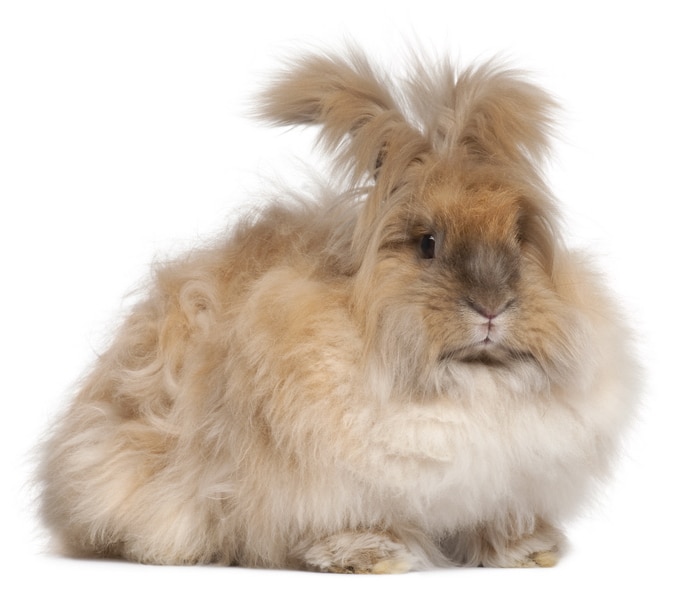
Here are 6 steps that you can take now to treat sore hocks in your angora rabbit
1. Keep the rabbit’s cage clean.
While you might want to allow manure to build up over winter to increase the warmth in your rabbit barn, don’t allow the manure to build up inside the cages. Urine and wool matted with manure on the cage bottom is a breeding ground for staph and strep bacteria. In summer, flies will also lay their eggs in rabbit manure and this can lead to a life threatening case of flystrike, as the maggots burrow into any exposed wounds or scratches. Clean rabbit cages at least once a week, and more often if there are babies in the cage. Use a wire brush to get the last of the hair and urine off the wire, too. In cases where urine and hair have caked onto the wires, you may need to burn the emptied cages with a propane torch to thoroughly remove both bacteria and residual hair and crud. We torch our cages between litters to ensure that the new babies have a fresh, clean start.
2. Make sure that the rabbit has lots of room to stretch out and lie down.
Rabbits should have enough room to lay down, stretched out, off their hocks. Rabbits will lay in this position most of the afternoon, every day. So if you find that your rabbits aren’t stretching out much, check and see if they have enough room to do so. A bigger cage, or even time out of the cage, hopping around your kitchen, will give them the break they need from the pressure on their hocks.
3. Provide straw bedding or a board for the rabbit to sit on.
We invested in some plastic cutting boards from the dollar store and provide them for our rabbits as a sitting board. This takes the pressure off their hocks. The boards can be hosed down and sterilized with bleach, or Dettol to keep them clean. Alternatively, a full flake of straw (not hay) will provide a cushioned area for a rabbit with sore hocks to sit on, while their feet heal. And the roughage will promote digestion. The rabbits will eat it.
4. Apply salve to the injury to reduce inflammation and promote healing.
Apply the salve morning and evening, for 7 days or until there is significant healing of the area. You can make your own salve or use an antibiotic ointment from your pharmacy. We’ve had success with both our own homemade Herbal ‘Rescue Remedy’ Ointment, and also with antibiotic first aid cream. Healing, however, is faster with herbal preparation.
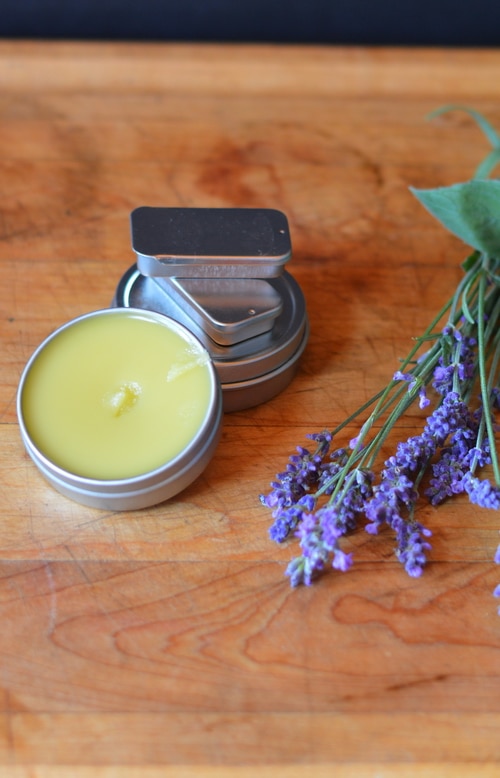
5. Make a healing salve to treat sore hocks
A healing salve can be made by combining an infusion of calendula, arnica, St. John’s Wort, lavender EO, balm of Gilead, comfrey, and plantain, with beeswax and coconut oil. This will reduce inflammation, take away the pain, and promote healing of the tissue. Check out this post on how to make your own herbal healing salve.
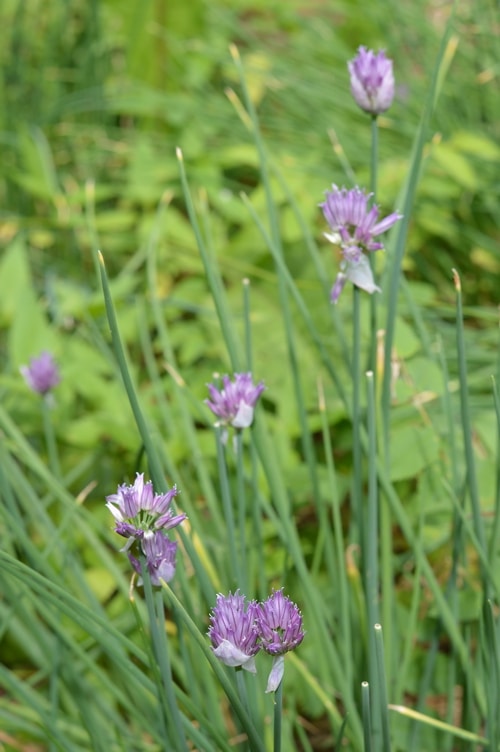
6. Feed bunny herbs that build up her immune system:
Chives, comfrey, thyme, oregano, mint, dandelion, yarrow, green onions, plantain, chickweed, and willow, are just some of the many herbs that will encourage healing and robust health in your rabbits. Start them slowly, just two or three leaves a day, if your bunny has been on a diet of commercial pellets.
Rabbits are ruminants and, like sheep and goats, need to have any change in their diets introduced slowly so they don’t get gut problems. So stick to just two or three leaves a day for at least two weeks. Then double the amount for another two weeks, and increase slowly from there, allowing at least two weeks at each stage, to allow the bunny’s stomach to adjust to the change in diet. Baby bunnies that are introduced to greens when just out of the nest box build up their stomach bacteria to handle greens — just like wild rabbits. But even with baby rabbits, introduce the greens slowly and build up their digestive bacteria.
A rabbit that has robust health, and adequate minerals and vitamins in her diet, are less likely to be set back by sore hocks.
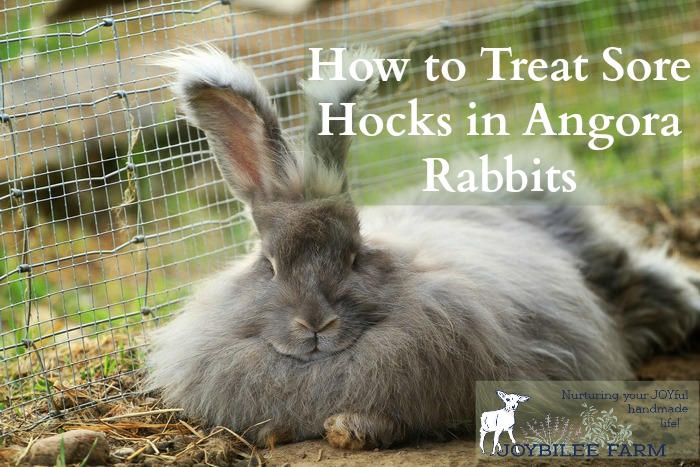
This is part of a series of posts on Angora Rabbits 101:
Part 1 -How to groom an Angora Rabbit that has Matts
Part 2 -6 steps to dealing with Sore hocks in your Angora Rabbits (this post)
Part 3 – Feeding your Angora Rabbits organically
Part 4 – Breeding for colour: Understanding Colour Genetics: The self rabbit
Part 5 – Angora Bunny Colour Genetics: The wild rabbit colouring
Part 6 – Angora Bunny Colour Genetics: The Shaded Gene


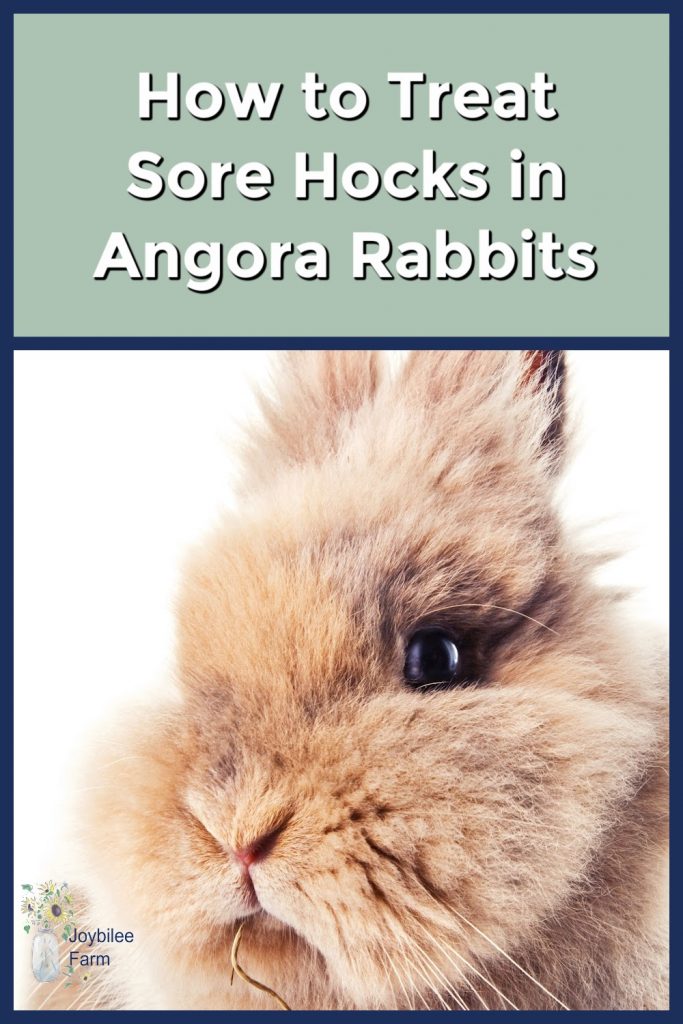

Hi, Debi, this is what I use. http://joybileefarm.com/how-to-make-herbal-first-aid-salve-for-livestock/
Can you please share with me the recipe you use for the healing salve? I have discovered some sores on my rabbits hind legs. I’ve already traced the problem now it’s time to address the healing regimen. Thank you so much. I thoroughly enjoy reading your site.
Check out http://www.problogger.com There is lots of information about how to set up a word press blog there. C.
I know this if off topic but I’m looking into starting my own blog and was curious what all is required to get setup? I’m assuming having a blog like yours would cost a pretty penny? I’m not very internet smart so I’m not 100% certain. Any suggestions or advice would be greatly appreciated. Thanks